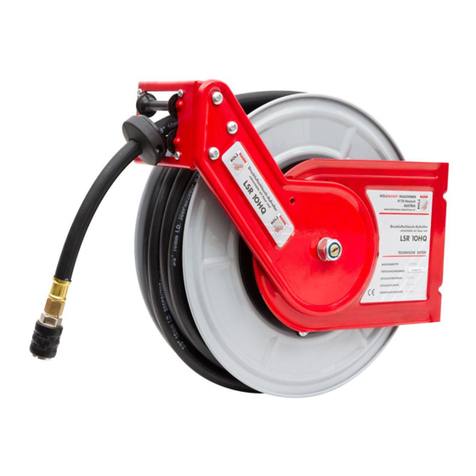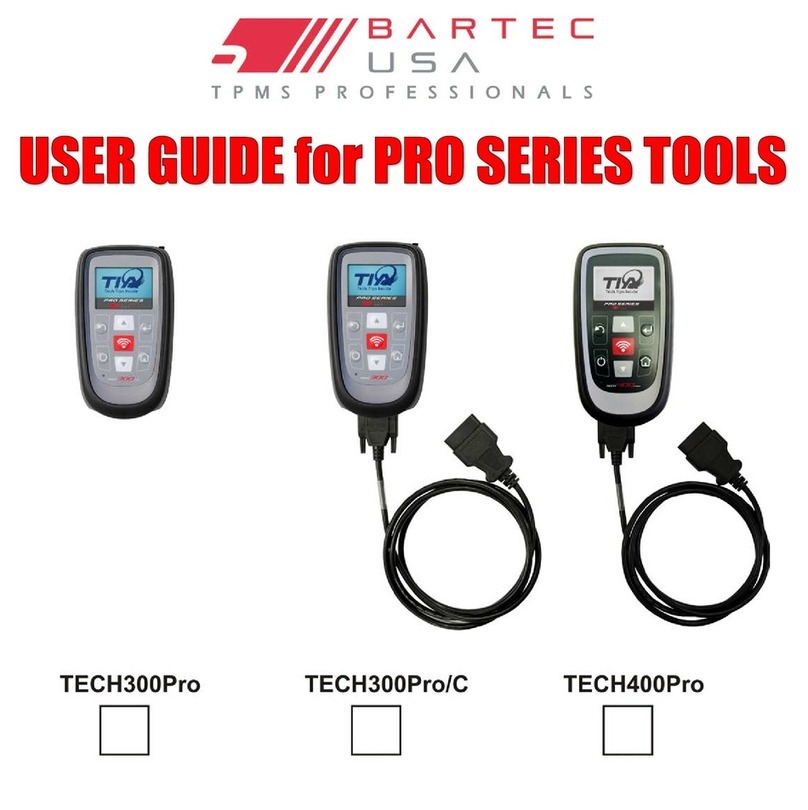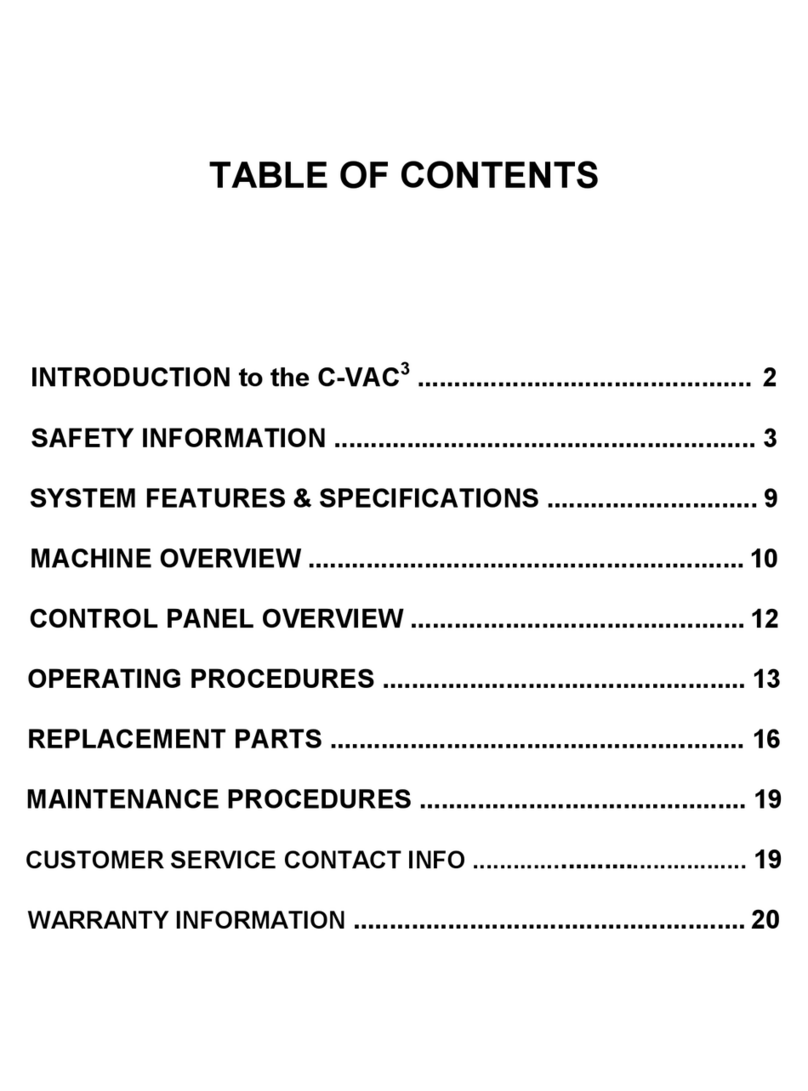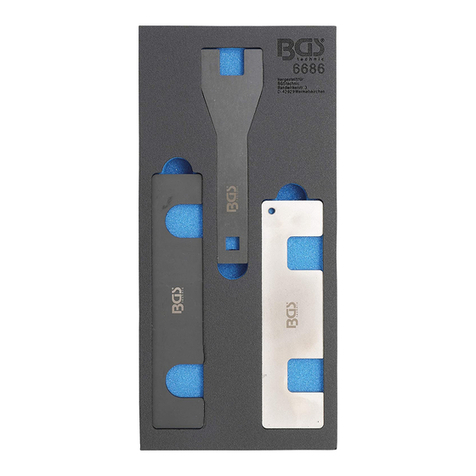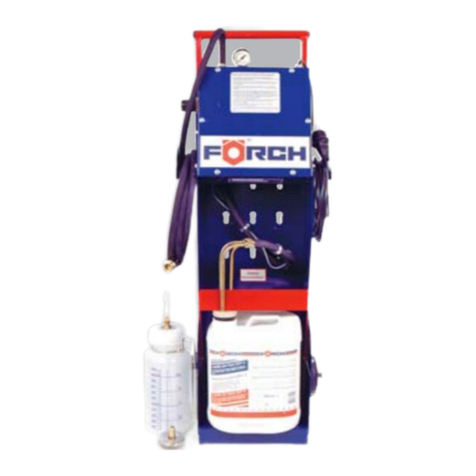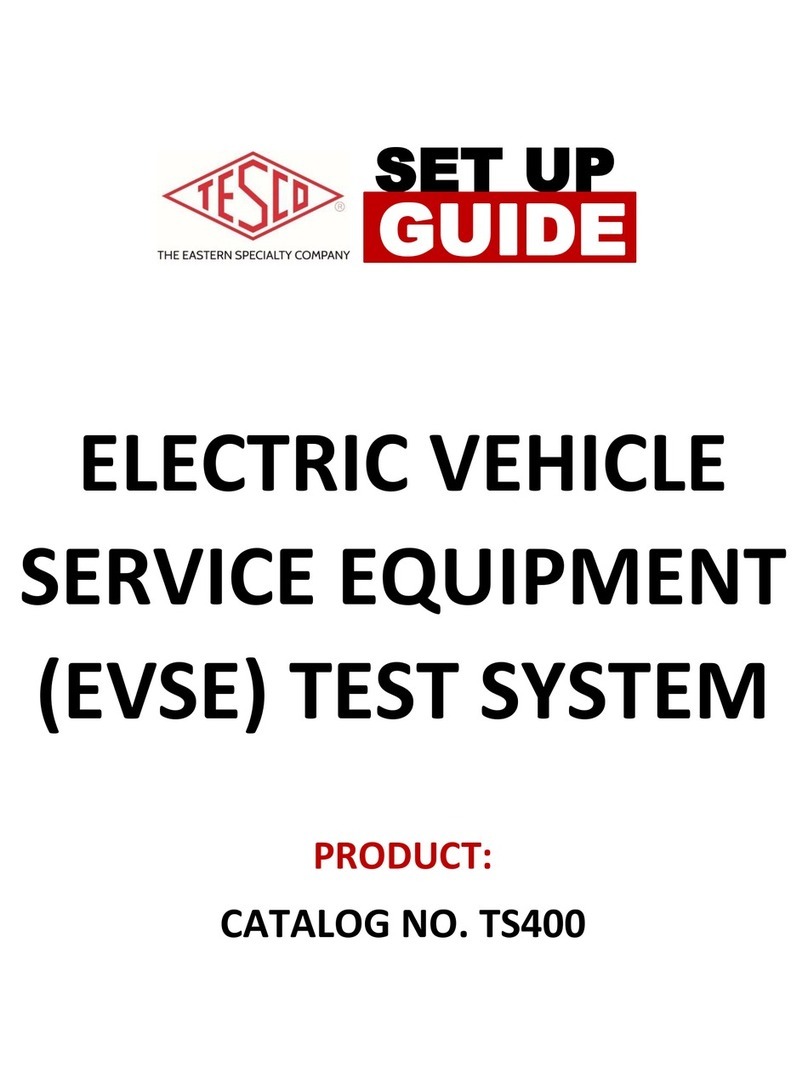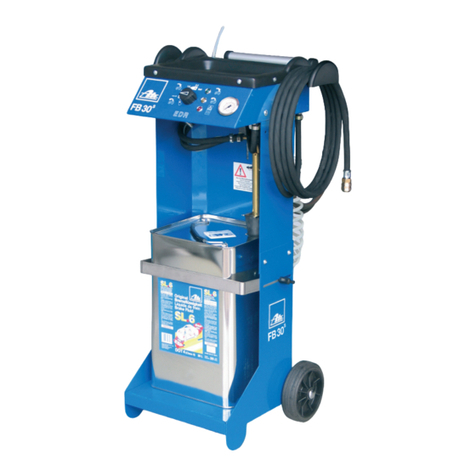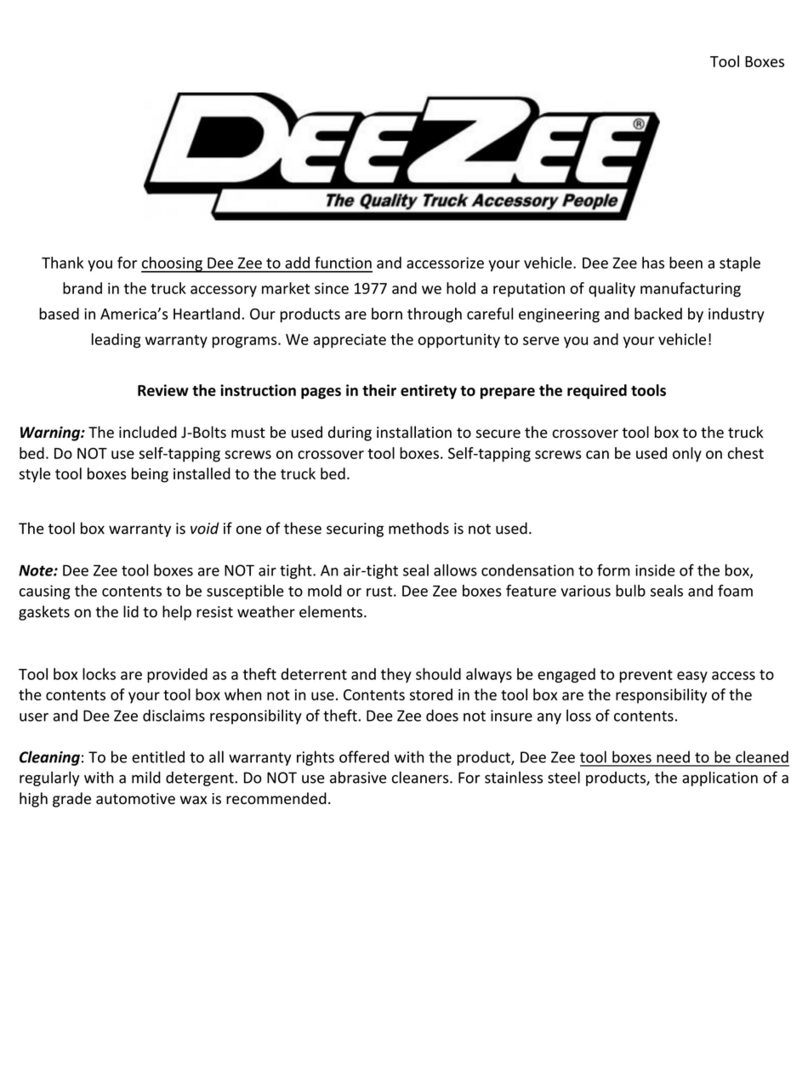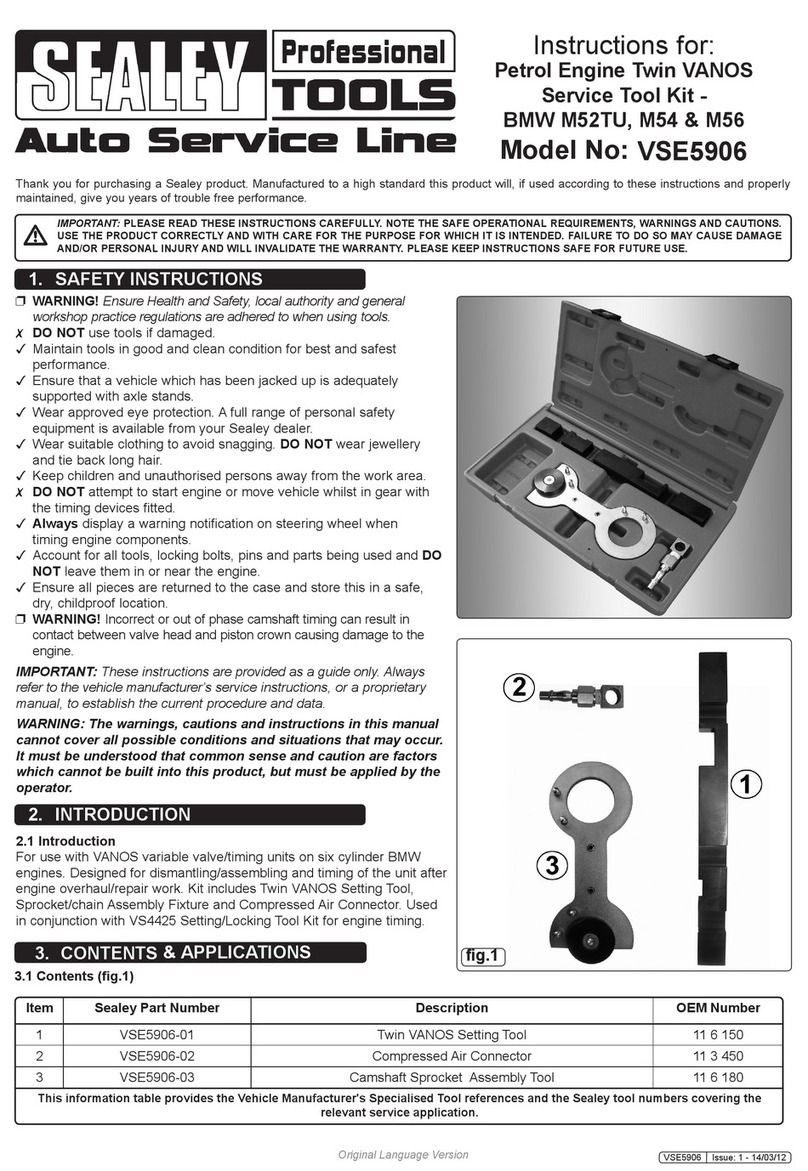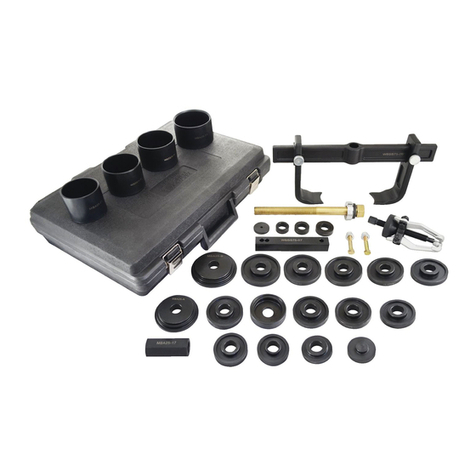Blue Giant ML10 Series Operating instructions

ML10 SERIES
MECHANICAL VEHICLE RESTRAINT SYSTEM
DO NOT INSTALL, OPERATE OR SERVICE THIS PRODUCT UNLESS YOU HAVE READ AND
FULLY UNDERSTOOD THE ENTIRE CONTENTS OF THIS MANUAL. FAILURE TO DO SO MAY
RESULT IN PROPERTY DAMAGE, BODILY INJURY OR DEATH.
INSTALLATION & OWNER’S MANUAL
Mechanical Vehicle Restraint System Issue Date: October 26, 2009. (Part# 038-538E) Rev.2
ML10 SERIES

TABLE OF CONTENTS
1. ABOUT THE ML10 MECHANICAL VEHICLE RESTRAINT 1
1.1 Owner’s Purchase Record 1
2. INTRODUCTION 2
2.1 Exclusion of Liability 2
2.2 Manufacturer's Note 2
3. OPERATOR’S MANUAL SAFETY MESSAGE COLOR IDENTIFICATION 3
3.1 Identifying Safety Warning Labels And Serial Plate Specifications 3
4. INSTALLATION INSTRUCTIONS 4
4.1 Installation Inspection 4
5. OPERATING INSTRUCTIONS 5
5.1 Engage Restraint 5
5.2 Disengage Restraint 5
6. MAINTENANCE 6
6.1 Planned Maintenance 6
6.2 Operator Maintenance and Care 6
6.3 Operator’s Daily Checklist 7
7. TROUBLESHOOTING 8
8. MECHANICAL COMPONENTS- STANDARD 9
9. MECHANICAL COMPONENTS- OPTIONAL 10

ABOUT THE ML10 MECHANICAL VEHICLE RESTRAINT
The Blue Giant ML10 Mechanical Vehicle Restraint is a high performance yet low cost solution for loading
docks worldwide. Its many features and benefits include:
• A restraining power of 30,000 lbs (13,636 kg).
• A broad horizontal restraining range of 0” to 12” (305mm).
• Services transport vehicles with ICC bars from 11” to 29” (279 mm to 737 mm) above ground level.
• Restraint Arm constructed from 1” (25 mm) solid steel.
• Minimal maintenance requirements.
• Single detachable control rod allows dock attendant to operate the ML10 safely and efficiently.
The system can be upgraded to include an Automatic Lights Communications System for added safety at the
loading dock.
Dealer:
Date in Service:
Number of Units:
Serial Number(s):
Door # :
OWNER’S PURCHASE RECORD
Please record information for future inquiries
The manufacturer offers a full line of dock levelers, dock safety equipment, accessories, ergonomic and scissor lift
equipment, and industrial trucks. Concurrent with a continuing product improvement program, specifications are subject
to change without notice. Please contact the manufacturer for latest information. Some features illustrated may be
optional in certain market areas.
1. 1 OWNER’S PURCHASE RECORD
MECHANICAL VEHICLE RESTRAINT SYSTEM
1

Loading Dock Equipment Manufacturers
A Product Section of Material Handling Industry of America,
A Division of Material Handling Industry
8720 Red Oak Blvd., Suite 201, Charlotte, NC, 28217-3992
Telephone: (704) 676-1190 Fax: (704) 676-1199
ALSO MEMBERS OF :
American National Standards Institute (ANSI)
1430 Broadway
New York, NY 10018
(212) 642-4900
LOADING DOCK EQUIPMENT MANUFACTURERS
2. INTRODUCTION
The following is a quick reference to important procedures that must be followed while using the Vehicle Restraint
System. It is not intended to cover, or suggest that it does cover, all procedures necessary to ensure safe operation. All
operators should be aware of and abide by all workplace safety regulations applicable to the operation of the Vehicle
Restraint System. These laws and regulations include but are not limited to:
• The Occupational Safety and Health Act (USA)
• Occupational Safety and Health Acts for Individual States (USA)
• Canadian Material Handling Regulations
For additional information on these regulations as well as industry standards that may apply to this product, please
contact:
The manufacturer assumes no liability for damage or injury to persons or property which occur as a result of defects or
faults in or incorrect use of Vehicle Restraint System. The manufacturer also assumes no liability for lost profits,
operating downtimes, or similar indirect losses incurred by the purchaser. Injury to third parties, irrespective of its
nature, is not subject to compensation.
The manufacturer reserves the right to make changes at any time to the modules, components, and accessories,
concurrent with its continuing product development program. Specifications, operating instructions, and illustrations
included in this manual are subject to change without notice. Please contact manufacturer for the latest information.
MANUFACTURER’S NOTE
The Vehicle Restraint has been carefully inspected and tested at the manufacturer’s plant prior to shipment, but should
be checked upon receipt for transport damage.Any observed transport damage is to be listed on the signed copy of the
freight document. Notify the freight forwarder of any damage WITHIN 48 HOURS.
2.2 EXCLUSION OF LIABILITY
2.3 MANUFACTURER’S NOTE
Thank you for purchasing Blue Giant products. We appreciate your business, and are confident that our product will
serve you for many years to come. In the event that you experience a problem with our product, our Warranty Center
is here to support the Blue Giant Product(s) that you have purchased.
To validate warranty on recently purchased equipment, please complete and submit your information with our on-line
Warranty Registration at www.BlueGiant.com.
For more information about Blue Giant's Warranty Support, please contact your local Blue Giant Equipment dealer,
representative or authorized partner near you. You may also visit www.BlueGiant.com or phone 1-905-457-3900.
* Note that failure to validate warranty at the time of receipt can seriously affect the outcome of any claim.
2.1 WARRANTY INFORMATION
MECHANICAL VEHICLE RESTRAINT SYSTEM
2

3.1 OPERATIONAL SAFETY WARNINGS
.
3. OPERATOR’S MANUAL SAFETY MESSAGE COLOR IDENTIFICATION
CRUSH HAZARD.
Keep Hands and Feet away from
operating space of the Restraint Arm.
This manual includes color-coded safety messages that clarify instructions and specify areas where potential hazard
exists. To prevent the possibility of equipment damage and serious injury or death, please observe strictly the
instructions and warnings contained in the messages. If warning decals become damaged or missing, replace them
immediately. Avoid accidents by recognizing dangerous procedures or situations before they occur.
Serious injury or death will likely occur if the instructions are
not followed. Procedures marked IMPORTANT must be followed in order to
prevent damage to machinery.
Serious injury or death may occur if the instructions are not
followed. Instructions marked CAUTION concern safe operating
procedure. Failure to comply may result in personal injury.
1. Installation must be performed only by trained and
authorized personnel.
2. Prior to installation, place adequate barriers to prevent
vehicle traffic from entering the work area.
3. Use caution when unbanding the Vehicle Restraint.
Keep hands and feet clear of pinch points and wear
appropriate safety attire.
4. During installation, anchors must be properly torqued to
achieve the necessary anchoring strength. DO NOT USE
IMPACT DRIVERS.
5. Any electrical work must be performed by qualified
personnel only.
6. Do not remove the wheel chocks until loading /unloading
is finished and the truck is cleared for departure or the
Vehicle Restraint has been released and the lights have
changed to RED inside and GREEN outside.
1. Do not ground welding equipment to any electrical
components.
2. Do not allow the drill to go too deeply into the control
box, as damage may occur to the control systems.
3. Never use air to blow debris from the control box. Use a
vacuum to perform any necessary cleaning.
4. Do not connect green ground lead into control box or
junction box until all welding has been completed.
5. If an extension plate / box is required, securely mount it
on the Restraint with hardware provided before shimming
and drilling.
6. Improper adjustments and / or lubrication may cause
operational problems with equipment.
1. Only trained personnel should operate or service this equipment.
2. Do not operate the Restraint until the transport vehicle is parked against the dock bumpers.
3. Always return the Restraint Arm to the released position after use.
4. Conduct routine inspections and maintenance. Failure to do so could cause equipment damage and or personal injury.
5. Always call your authorized service representative or manufacturer immediately if a malfunction occurs.
1. Do not operate the Vehicle Restraint while anyone is standing in its path.
2. Lift the Vehicle Restraint with suitable hoisting equipment only. Do not stand under
the Restraint or any heavy object while it is being hoisted.
MECHANICAL VEHICLE RESTRAINT SYSTEM
3

4. INSTALLATION INSTRUCTIONS
1. Installation must only be performed by trained and authorized personnel.
2. Prior to installation, place adequate barriers to prevent vehicle traffic from entering the work
area.
3. Use caution when unbanding the Vehicle Restraint. Keep hands and feet clear of pinch points
and wear appropriate safety attire.
1. Prior to installation, clear away all debris and dirt from the
driveway and dock face where installation is to take place,
and perform a visual inspection of both areas.
2. To ensure maximum strength, install the Vehicle Restraint
on a poured concrete dock face and driveway. If
installation will be performed on cement block construction
or a poor concrete dock face, contact the manufacturer for
custom lag plates and/or lag anchors. Damaged asphalt
driveways should be replaced by a 6” (150mm) deep
concrete pad.
3. Using proper hoisting equipment, position the ML10 square
against the dock face and centered with the door opening.
4. Keep the Vehicle Restraint base-plate at a 90 degree angle
to the dock face and place a sufficient density of shims (not
supplied) between the driveway surface and the outer
edge of the base-plate. (See illustration at the bottom of
this page.) Shims must be a minimum 13” (326mm) x 6”
(150mm) in size and must be permanently welded together
to the base-plate. Note: If an extension plate / box is
required, securely mount it onto the ML10 with hardware
provided before shimming and drilling.
5. With the ML10 properly positioned, and using back-plate
as a template, drill six holes 5/8" dia. X 6" (15mm x 150mm)
deep, in the dock face concrete. After cleaning out the
holes, insert and permanently install anchors and lag bolts
supplied with the unit. Tighten securely.
6. When optional light package is included, mount the control
station c/w operating switch and communication lights
permanently onto an interior wall adjacent to the doorway
opening, at approx. 50" (1270mm) above floor level.
7. Mount the exterior signs (and communication lights, if
applicable) permanently onto the exterior wall
adjacent to the doorway at approx. 84" (2134mm)
above the driveway.
8. Securely mount the Operating Hazards placards
permanently onto an interior wall adjacent to the
control station in a location approx. 6 feet (1800mm)
above floor level. Confirm that the placard is clearly
legible to the operator.
9. When optional light package is included and conduits
were not poured-in with the concrete, install 1/2" dia.
(13mm) rigid conduit for (surface mounted) electrical
wires from the ML10 along the dock face, up and
through the wall, and up to the control station.
10. Install 1/2" dia. (13mm) rigid conduit from the control
station, through the wall to the exterior
communication lights.
11. Complete the electrical hook-up between the ML10
and control station, and exterior lights to control
station.
12. Remove the Release Arm from its vertical shipping
position on the ML10 and using the removed pin -
spacers - cotter pin, remount horizontally into the
same brackets in its working position.
13. Mount Hanger Bracket for Control Rod in the
appropriate location on interior wall adjacent to
ML10. Place the Control Rod in the bracket.
14. Review Installation Instructions and verify that all
work has been performed.
Clean up the entire work area and apply touch-up
paint to all welds, scratches and burns. Ensure that all
fasteners have been tightened and locked. Check that
all electrical conduits and wires are mechanically
protected against damage and are adequately
secured. Cycle test the ML10 several times. Ensure
that the lock is fully engaged when the Restraint Arm
is fully raised (vertical). Test operate theAutomatically
Actuated Communication Lights System (if
applicable). Replace all wiring diagrams into the
control box. Leave these instructions with the ML10
for use by the operator.
IMPORTANT
If an extension plate / box is required,
securely mount it on the hardware
provided before shimming and drilling.
Do not attempt to lift the ML10 without
suitable hoisting equipment. The
approximate weight of the Vehicle
Restraint is 180 lbs.
4.1 Final Inspection
MECHANICAL VEHICLE RESTRAINT SYSTEM
4

5. OPERATING INSTRUCTIONS
1. When the freight carrier reverses into position firmly
against the dock bumpers, activate the ML10 by using the
Control Rod to press down on the Engagement Arm until the
Restraint Arm is in the fully vertical position. Vehicle is not
restrained if the Restraining Arm is not fully vertical. If
Restraint is unusable, tires MUST be manually chocked.
2. Do a visual inspection to confirm that the vehicle under
ride guard is securely restrained before proceeding with
loading / unloading operation. For added safety, use wheel
chocks in addition to the Vehicle Restraint when operating in
manual override mode .
3. With vehicle secured, perform loading / unloading
operation.
1. When the loading / unloading operation is completed and all
personnel and equipment are clear of the vehicle, release the
ML10 by quickly and firmly by pulling up on the Release Arm
with the Control Rod. The RestrainingArm will return to the fully
lowered, horizontal position. (If the freight carrier is applying
pressure to the Restraining Arm, it may be necessary to have
the driver back up before the Restraining Arm can be
released.)
2. The vehicle departs and normal cycle is completed.
1
2
5.1 Engage Restraint
5.2 Disengage Restraint
MECHANICAL VEHICLE RESTRAINT SYSTEM
5

6. MAINTENANCE
PLANNED MAINTENANCE
In addition to the daily operator inspection, Blue Giant recommends (and government regulations may require) that a
planned maintenance and safety inspection program (PM) be performed by a trained and authorized mechanic on a
regular basis to keep your equipment in safe operating condition. The PM will provide an opportunity to make a thorough
inspection of the Vehicle Restraint’s operating condition.
Necessary adjustments and repairs can be done during the PM, which will keep components in good operating form,
reduce unscheduled downtime and increase safety. The procedures for a periodic planned maintenance program that
covers inspections, operational checks, cleaning, lubrication, and minor adjustments are outlined in this manual.
This manual is intended to be readily available. Keep it near the Vehicle Restraint as a ready reference for anyone who
may operate or service it.
OPERATOR MAINTENANCE AND CARE
It is the operator’s responsibility to check the Vehicle Restraint’s condition before use and make sure that it is safe to
operate. Perform a visual inspection of the Restraint and its major components. This includes the Light Communications
System, if used in conjunction with the Restraint.
If damage or maintenance problems are observed, either during an inspection or while operating the Vehicle Restraint,
a report must be made to a supervisor and repairs completed by qualified personnel before the unit is put back into
service.
6.1 Planned Maintenance
6.2 Operator Maintenance and Care
MECHANICAL VEHICLE RESTRAINT SYSTEM
6

INSTRUCTIONS FOR USE: Indicate “OK for Use” with a check mark ( ) in the
appropriate box of each inspection point.
Visually inspect the Vehicle Restraint and take note of obvious damage that may
have been caused by operation during the last shift.
Check that the Operating Hazards Placard is present in correct location and is
legible.
Inspect for damaged or missing parts, rust, corrosion, bent parts, cracks, etc.
Inspect operating controls to assure they are not missing, damaged or broken.
Clean away all foreign material such as parts of broken skids, etc. from area in
which the Vehicle Restraint is located.
Check for missing or damaged dock bumpers mounted on dock face.
Visually inspect the Vehicle Restraint for signs of structural damage or mechanical
malfunction as you operate the Vehicle Restraint throughout the day. Be alert to
abnormal sounds or operation.
Explain faults briefly in the space provided below.
INSPECTED BY: DATE:
Forward checklist to the person responsible for Vehicle Restraint maintenance.
6. MAINTENANCE
6.3 Operator’s Daily Checklist
MECHANICAL VEHICLE RESTRAINT SYSTEM
7

7. TROUBLESHOOTING
Do not attempt to install, make repairs or adjustments. Only a trained and authorized
service technician should perform the installation process.
Contact your local dealer or distributor for assistance.
PROBLEM CAUSE
PROBLEM
Restraining Arm will not
raise when the operator
pushes down on the
Actuating Arm.
1. Damaged Actuating Arm or Linkage.
2. Foreign material preventing movement of actuating arm or linkage.
3. Lack of lubrication at pivot points.
4. Operator needs to push down with more force.
Restraining Arm is not
reaching fully vertical
position.
1. Foreign material is preventing full movement of the actuating linkage.
2. ICC Bar on the transport vehicle is bent forward or otherwise undetectable by the
sensor.
3. The truck is not parked firmly and squarely against dock bumpers, causing the
Restraint Arm to contact the ICC Bar.
4. Damaged Actuating Arm or Linkage.
5. Lack of lubrication at pivot points.
6. Operator needs to push down with more force.
Restraining Arm raises to
full vertical position, but
does not lock.
1. Lock (internal component) is not lowering into its locked position. Foreign material
inside enclosure may be preventing normal movement of the lock.
Restraining Arm will not
lower when the operator
raises the Release Arm.
1. Lock is not released when Release Arm is raised. Pull the Control Rod up quickly
and sharply.
2. The freight carrier is applying pressure against the Restraint Arm and lock. Reverse
the vehicle firmly against the dock bumpers, and then operate the release arm quickly
and sharply.
3. Foreign material may be lodged inside enclosure, preventing lock from raising.
4. Damaged or broken actuating linkage may be preventing the Restraint Arm from
lowering.
5. Damaged or broken springs.
6. Lack of lubrication.
MECHANICAL VEHICLE RESTRAINT SYSTEM
8

9. MECHANICAL COMPONENTS- STANDARD
31
ITEM QTY PART NO. DESCRIPTION
1 1 522-5003C BODY WELDMENT
2 1 522-5004C LOCKING ARM ASSEMBLY
3 1 522-5005A SHAFT ARM ASSEMBLY
4 1 011-141 ¼-20 UNC. X 3.5 LG. HEX HEAD CAPSCREW
5
1
011-506
¼-20 UNC HEX NUT
6
1
091-041
BUMPER
7
2
019-500
¼” STRAIGHT GREASE NIPPLE
8
2
013-066
5/32” DIA. X 1-1/4’ SPRING PIN
9
2
013-025
3/16 DIA. X 1-1/2” LG. COTTER PIN
10
1
013-018
3/32 DIA. X 1” LG. COTTER PIN
11 1 522-5001A LOCK WELDMENT
12 1 017-012 TENSION SPRING
13 1 522-0000A RELEASE ARM
14 1 107-196 CLEVIS PIN
15 6 105-880 WASHER, SPACER ¾ X 1/8
16
1
782-391A
LOCK ROLLER SHAFT ASSEMBLY
17
1
522-0010
ACTUATOR LINKAGE
18
1
522-0010A
ACTUATING ROD
19
2
119-278
CLEVIS PIN
20
1
119-409A
BODY COVER
21
2
012-211
5/16 DIA. FLAT WASHER
22 2 011-020 ¼-20 UNC. X ¾ R/H SLOT MACHINE SCREW
23 1 038-064 DRIVER WARNING SIGN
24 1 107-046 WASHER
25 1 012-239 ½ I.D. X 1” O.D. X 1/8” WASHER
28 1 028-200 PROXIMITY SENSOR
29
1
52-003236
PROXIMITY HOLDER
30
1
52-003245
WAND CAM
31
1
782-371
CONTROL ROD
OPTIONAL FOR INTERLOCK SWITCH *
OPTIONAL FOR INTERLOCK SWITCH *
OPTIONAL FOR INTERLOCK SWITCH *
NOT SHOWN
NOT SHOWN
NOT SHOWN
NOT SHOWN
NOT SHOWN
MECHANICAL VEHICLE RESTRAINT SYSTEM
9

9. MECHANICAL COMPONENTS- OPTIONAL
ITEM QTY PART NO. DESCRIPTION
28 1 028-200 Proximity Sensor
29
30 1 52-003245 Wand Cam
32
PROTECTIVE COVER REMOVED FOR CLARITY
1119-722 Protective Cover (not shown)
28
29
30
152-003236 Proximity Holder
MECHANICAL VEHICLE RESTRAINT SYSTEM
10

NOTES
MECHANICAL VEHICLE RESTRAINT SYSTEM
11

NOTES
MECHANICAL VEHICLE RESTRAINT SYSTEM
12

NOTES
MECHANICAL VEHICLE RESTRAINT SYSTEM
13

85 Heart Lake Road South
Brampton, Ontario, Canada L6W 3K2
Phone : 905-457-3900 Fax : 905-457-2313
www.BlueGiant.com
BLUE GIANT EQUIPMENT CORPORATION
©2012 Blue Giant Equipment Corporation
if calling within North America:
Phone: 1-800-668-7078 Fax: 1-888-378-5781
Table of contents


